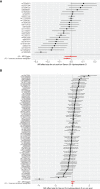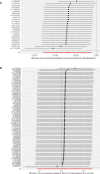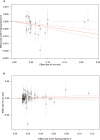Assessment of causal associations between uric acid and 25-hydroxyvitamin D levels
- PMID: 36583002
- PMCID: PMC9792848
- DOI: 10.3389/fendo.2022.1024675
Assessment of causal associations between uric acid and 25-hydroxyvitamin D levels
Abstract
Background: Previous observational studies have revealed the association between serum uric acid and 25-hydroxyvitamin D. However, the causality and the direction of the associations remain unknown. Thus, we performed a two-sample bidirectional Mendelian Randomization (MR) analysis to investigate the causal association between uric acid and 25-hydroxyvitamin D and to determine the direction of the association.
Method: Based on the summary-level GWAS data from large genome-wide association studies, several steps were taken in our analysis to select eligible single-nucleotide polymorphisms (SNPs), which were strongly related to exposure as the instrumental variables. We used different analytical methods, such as inverse-variance weighting (IVW) method, weighted median, MR-Egger regression, and weighted mode method, to make our result more robust and reliable. The IVW method was used as the primary analysis. The Cochran's Q test, MR-Egger intercept test, MR-PRESSO method, and "leave-one-out" sensitivity analysis was performed to evaluate the heterogeneities, horizontal pleiotropy, and robustness of the results. MR analyses were also conducted using genetic risk scores (GRS) as instrumental variables in both directions by using the same summary-level GWAS data.
Results: Our two-sample MR analysis suggested a causal association of genetically predicted uric acid on 25-hydroxyvitamin D [IVW method: β(SE), -0.0352(0.0149); p = 0.0178], which suggested that a per mg/dl increase in uric acid was associated with a decrease of 0.74 nmol/L of 25-hydroxyvitamin D, and the above results remained stable in the sensitivity analysis. By contrast, four MR methods suggested no causal relationship of 25-hydroxyvitamin D on serum uric acid [IVW β(SE), 0.0139 (0.0635); p = 0.826; MR-Egger β(SE), 0.0671 (0.108); p = 0.537; weighted median β(SE), 0.0933 (0.0495); p = 0.0598; weighted mode β(SE), 0.0562 (0.0463); p = 0.228, respectively]. After excluding the SNPs, which were associated with confounding factors and outlier SNPs, the IVW method suggested that there was still no causal association of 25-hydroxyvitamin D on serum uric acid. The GRS approach showed similar results.
Conclusions: Serum uric acid may causally affect the 25-hydroxyvitamin D levels, whereas the causal role of 25-hydroxyvitamin D on uric acid was not supported in our MR analysis. Our findings suggest that increased levels of uric acid should prompt investigation for vitamin D deficiency.
Keywords: 25-hydroxyvitamin D; causality; inverse-variance weighting method; mendelian randomization; uric acid.
Copyright © 2022 Han, Zhang and Zeng.
Conflict of interest statement
The authors declare that the research was conducted in the absence of any commercial or financial relationships that could be construed as a potential conflict of interest.
Figures






Similar articles
-
[Genetic Causation Analysis of Hyperandrogenemia Testing Indicators and Preeclampsia].Sichuan Da Xue Xue Bao Yi Xue Ban. 2024 May 20;55(3):566-573. doi: 10.12182/20240560106. Sichuan Da Xue Xue Bao Yi Xue Ban. 2024. PMID: 38948277 Free PMC article. Chinese.
-
Causal association of serum vitamin D levels with urolithiasis: a bidirectional two-sample Mendelian randomization study.Eur J Nutr. 2024 Nov 30;64(1):39. doi: 10.1007/s00394-024-03553-1. Eur J Nutr. 2024. PMID: 39614876
-
Mendelian randomization analysis of blood uric acid and risk of preeclampsia: based on GWAS and eQTL data.J Matern Fetal Neonatal Med. 2025 Dec;38(1):2443673. doi: 10.1080/14767058.2024.2443673. Epub 2025 Jan 2. J Matern Fetal Neonatal Med. 2025. PMID: 39746786
-
Phenome-wide Mendelian randomization study evaluating the association of circulating vitamin D with complex diseases.Front Nutr. 2023 Mar 29;10:1108477. doi: 10.3389/fnut.2023.1108477. eCollection 2023. Front Nutr. 2023. PMID: 37063319 Free PMC article. Review.
-
Serum uric acid levels as a causal factor in hypertension: Insights from Mendelian randomization analysis.Clin Exp Hypertens. 2025 Dec;47(1):2496514. doi: 10.1080/10641963.2025.2496514. Epub 2025 May 5. Clin Exp Hypertens. 2025. PMID: 40325623 Review.
Cited by
-
Association of serum 25-hydroxyvitamin D concentrations with all-cause and cause-specific mortality among individuals with gout and hyperuricemia.Nutr J. 2024 Aug 9;23(1):89. doi: 10.1186/s12937-024-00992-8. Nutr J. 2024. PMID: 39123196 Free PMC article.
-
Exploring the bidirectional causal relationship between Autism Spectrum Disorder and Schizophrenia using Mendelian randomization.Medicine (Baltimore). 2025 Apr 11;104(15):e42119. doi: 10.1097/MD.0000000000042119. Medicine (Baltimore). 2025. PMID: 40228250 Free PMC article.
-
Hyperuricemia and its related diseases: mechanisms and advances in therapy.Signal Transduct Target Ther. 2024 Aug 28;9(1):212. doi: 10.1038/s41392-024-01916-y. Signal Transduct Target Ther. 2024. PMID: 39191722 Free PMC article. Review.
References
Publication types
MeSH terms
Substances
LinkOut - more resources
Full Text Sources
Medical

